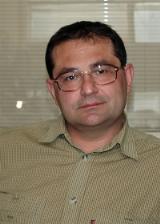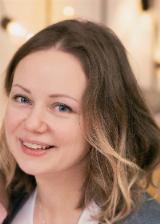Laboratory of Applied Physiology of Human Higher Nervous Activity
The main directions of scientific activity.
The laboratory was founded in 1970 and has been led by Professor Mikhail Vasilyevich Frolov from 1970 until 2006. From 2007 until 2020, Professor Natalia Nikolaevna Lebedeva, a laureate of the State Prize of the Russian Federation and a specialist in magnetobiology, psychophysiology, and physiology of functional states, was in charge of the lab. Since 2020, Ekaterina Dmitrievna Karimova has been leading the team, a young researcher in the field of neurophysiology who is continuing her mentor's work. Today, a team of young and proactive medical physicists, biophysicists and physiologists are working in the lab, developing areas such as neurophysiology, social interactions, non-verbal communication, brain function in virtual reality environments, and MRI studies of different pathologies.
The main areas of research conducted by the Laboratory are devoted to the study of the brain basis of typical functional states of operator activity (emotional stress, fatigue, etc.) and altered states of consciousness, on the one hand, to the analysis of the conditions of clinical patients (emotional disturbances spheres, local brain damage, etc.) - on the other. In particular, the natural effects of changes in these states on the quality and different modal errors of professional activity (behavior) are investigated. According to the results of such studies, diagnostic criteria are formed and methods for monitoring current functional states are developed. The diagnostic information obtained in this way serves the purpose of limiting the negative and using the positive effects of the functional state (FS) on the behavior characteristics.
The Laboratory has developed an original concept of the functional state, determined its fundamental variables (initial complex of functional properties and qualities, need, input effect) and basic functions (reflective and regulatory). In this case, FS serves as a determining factor for any activity, including the higher nervous one. Thus, the traditional "stimulus-response" relationship is translated into the "stimulus-reaction-state" relationship.
On the basis of this concept, the Laboratory develops methods for monitoring a functional system based on changes in the FS of its components and the relationships between them. At the same time, along with others, both contact (EEG, ECG, etc.) and non-contact methods of recording informative indicators of the state are used, which allows diagnosing FS for an arbitrarily long time, either explicitly or covertly, without contributing to the working person ( ) physical and psychological discomfort. Methods of control of this kind have been tested in aviation, aerospace, transport and in the clinic, in model experiments, etc.
In addition, since 1997, the Laboratory has been conducting studies of the neurophysiological mechanisms of the biological effects of low-intensity electromagnetic fields (EMF), including the EMF of mobile phones.
The laboratory currently employs 1 laureate of the State Prize in Science and Technology of the USSR, 1 laureate of the State Prize in Science and Technology of the Russian Federation, and 2 laureates of the Prize of the USSR Council of Ministers in science and technology. During the existence of the Laboratory, employees published 15 scientific monographs, over 600 scientific articles, and received 14 patents.
The most important results of scientific research:
- It is shown that the well-known formula of Price and Burrell, which they called the "general law of human emotions", is a special case of a similar, but more complex relationship, which we obtained, where the disadvantages (for example, the possibility of emotion with full awareness) are inherent . At the same time, in the indicated relation, which is non-linear in nature, linearized sections can be singled out, which make it possible to use an expression equivalent to the “formula of emotions” by P.V. Simonov. However, in this expression there are coefficients depending on the magnitude of the variables themselves, which distinguishes it from the “formula” of emotions, making certain corrections to the latter.
The study of hypnosis, considered as a possible model of an altered state of consciousness, analysis of the phases of immersion in hypnosis and withdrawal from it showed the presence of, respectively, negative and positive spasmodic shifts in the average frequency of the CM oscillations of electrical brain potentials relative to its mean value. These shifts are accompanied by seconds-decasecond waves in the first case and decasecond-minute fluctuations - in the second. Restoration of the SM indicators to the levels of hypnotaxia and the background of the aftereffect turns out to be much more protracted in the latter situation compared to the immersion phase. The described patterns were observed in both hemispheres of the brain, EEG derivations from which were demodulated for the purpose of non-artifact isolation and specific analysis of CM oscillations by methods developed in the Laboratory.
Listening to the subject of classical music with an intensity at the level of quiet conversation, in which, as was shown earlier, the quality of operator (recognition) activity is optimized, leads to significant changes in the range of superslow oscillations extracted from the EEG derivations without the artifact using Hilbert's transformations. It is shown that the average Hilbert frequency may decrease or increase relative to the background level, and in the latter case, its abrupt shifts were observed, similar to those when entering into hypnosis and withdrawal from it. These changes have occurred in EEG leads from both hemispheres of the brain, and the sudden changes themselves can serve as a possible characteristic of an altered state of consciousness. - The study of hypnosis, considered as a possible model of an altered state of consciousness, analysis of the phases of immersion in hypnosis and withdrawal from it showed the presence of, respectively, negative and positive spasmodic shifts in the average frequency of the CM oscillations of electrical brain potentials relative to its mean value. These shifts are accompanied by seconds-decasecond waves in the first case and decasecond-minute fluctuations - in the second. Restoration of the SM indicators to the levels of hypnotaxia and the background of the aftereffect turns out to be much more protracted in the latter situation compared to the immersion phase. The described patterns were observed in both hemispheres of the brain, EEG derivations from which were demodulated for the purpose of non-artifact isolation and specific analysis of CM oscillations by methods developed in the Laboratory.
- Listening to the subject of classical music with an intensity at the level of quiet conversation, in which, as was shown earlier, the quality of operator (recognition) activity is optimized, leads to significant changes in the range of superslow oscillations extracted from the EEG derivations without the artifact using Hilbert's transformations. It is shown that the average Hilbert frequency may decrease or increase relative to the background level, and in the latter case, its abrupt shifts were observed, similar to those when entering into hypnosis and withdrawal from it. These changes have occurred in EEG leads from both hemispheres of the brain, and the sudden changes themselves can serve as a possible characteristic of an altered state of consciousness.
- The opposite dynamics of the significant EEG parameters of the anterior zones of the neocortex is shown with the correct and erroneous identification of the stimulus under the conditions of different noisiness of the latter. So, at the pre-stimulus stages, the amplification of beta-waves with proper identification and the decrease - with erroneous actions. The spectral EEG components obtained at poststimulus epochs, on the contrary, are more pronounced in the case of erroneous actions than with the correct identification in the beta and theta oscillations. An increase in noise level (up to 20–25%) leads to an increase in the functional asymmetry of the brain hemispheres in terms of the global correlation dimension D2 (nonlinear EEG characteristic), especially before erroneous actions such as “false alarm”. In conditions of prolonged monotony, the multidirectional changes in D2 correspond mainly to the large and small (optimal) identification time.
- When using EEG assessments, especially of the correlation type, the issues of eliminating electrophysiological interference and, in particular, the additive and multiplicative effects of the galvanic skin response (GSR) on the EEG derivation become important. The Laboratory has developed methods to isolate CGR from EEG-leads in close to real time. This allows, firstly, to use the GSR separately as an indicator of diagnosis and, secondly, to neutralize these effects when analyzing the potentials of the brain in states of calm wakefulness and emotional stress.
- A tendency has been found to reduce the slow-wave phase of night sleep, especially in the second half of the night, under the action of the electromagnetic field of a mobile phone located at the head of the subject. This kind of data was obtained in comparison with the placebo effect according to the results of nonlinear dynamic analysis of 8-hour EEG recordings, calculating the D2 value, decreasing as sleep deepens.
- Low intensity complex-modulated electromagnetic radiation affects not only the psycho-physiological reactions of a human operator in monotonous working conditions, but also the cardiac rhythm regulation system, which, in turn, reflects the adaptive response of the whole organism, while improving the quality of operator activity is accompanied by an increase in the voltage of regulatory systems , when higher levels of management are involved in the regulation process.
- Significant differences were revealed in the fractal dimension of the speech signal in the modeling of emotions: a decrease in the fractal dimension in the emotion of fear and an increase in the emotion of anger and joy compared to a neutral state. The gender differences in the characteristics of the speech signal in terms of the fractal dimension and representation of formants when modeling emotional states are established.
- The problems of diagnosing the states of operators and patients with depression in their speech are considered. At the same time, indicators of the temporal stream of speech signal and intonation of speech were used, on the basis of which the ideator, motor and intonational components of the state were evaluated. These estimates, as shown by the analysis, correlated with the dynamics of the functional state of the operators performing professional activities in real conditions, as well as with the nature and severity of the illness of psychogenic depression. The latter was differentiated according to the type of leading affect (melancholy, anxiety) in the space of speech parameters, which contained non-intersecting areas of similar (but different in range) changes in state scores separately for healthy and sick individuals. Differentiation of states simultaneously in both groups of subjects is carried out using decision rules.
- As a result of the conducted research, the high information content of the speech signal in the diagnosis of psychogenic paroxysmal disorders in identifying the phenomenological features of the latter (panic attacks, demonstrative seizures) was shown. The results obtained allowed us to separate the studied psychogenic seizures in the coordinates of intonation, motor and ideator levels of speech. In the absence of the "fear" factor in the structure of paroxysm (demonstrative seizures), the temporal characteristics of the speech signal were shifted towards psychomotor agitation, and in the presence of the "fear" component in the attack (panic attacks), psychomotor inhibition was noted. The stated results can significantly improve the quality of diagnosis of paroxysmal disorders.
- In the context of operator activity, it is shown that false alarms are preceded by an increased level of correlation of beta-range waves in the anterior regions of the neocortex, while errors in the “signal skip” type are observed against the background of increased alpha coherence in pairs of leads including the occipital cortex. The state of the central nervous system in the conditions of monotonous discernment work with a small number of choices is characterized by a distinct difference in the level of the global correlation dimension between correct and erroneous actions. Increasing information uncertainty leads to the erasure of such differences.
Books
- Betsky O.V., Kislov V.V., Lebedeva N.N. Millimeter waves and living systems: M.: Sainspress, 2004, 273p. (monography).
- Betskii O.V.,Lebedeva N.N. Low-Intensity Millimeter Waves in Medicine. – In: “Clinical Application of Bioelectromagnetic Medicine”, USA, N-Y, Marcel Dekker, Inc., 2003.
- Sidorova O.A. Neuropsychology of emotions. M, Nauka, 2001 146p.
Список сотрудников
Publication list
Papers
- Karimova E.D., Smolskaya V.D., Naratkina A.A. Activity of the mirror system of the brain in people with depressive symptom complex. Journal of Higher Nervous Activity named after. I.P. Pavlova. 2023. V. 73. N. 2. P. 230-241. DOI: 10.31857/S0044467723020053
- Karimova E.D., Gulyaeva A., Katermin N.S. The degree of mu rhythm suppression in women is associated with presence of children as well as empathy and anxiety level. Social Neuroscience. 2022. V. 17. N. 4. P. 382-396. DOI: 10.1080/17470919.2022.2112753
- Lebedeva N.N., Karimova E.D., Potapova R.K., Potapov V.V. Comprehensive study of the functional state changes when perceiving media content of different modality. Zhurnal Vysshei Nervnoi Deyatel’nosti imeni I. P. Pavlova. 2021. V. 71. N. 1. P. 86-103. DOI: 10.31857/S004446772101007X
- Kolesov D.V., Ivanova V.O., Sokolinskaya E.L., Kost L.A., Balaban P.M., Lukyanov K.A., Nikitin E.S., Bogdanov A.V. Impacts of OrX and cAMP-insensitive Orco to the insect olfactory heteromer activity. Molecular Biology Reports. 2021. V. 48. N. 5. P. 4549-4561. DOI: 10.1007/s11033-021-06480-0
- Potapova R., Potapov V., Lebedeva N., Karimova E.D., Bobrov N. Media Content vs Nature Stimuli Influence on Human Brain Activity. Speech and Computer. SPECOM 2021. Lecture Notes in Computer Science. 2021. V. 12997. DOI: 10.1007/978-3-030-87802-3_48
- Lebedeva N.N., Karimova E.D. Stability of Human EEG Patterns in Different Tasks: The Person Authentication Problem. Zhurnal Vysshei Nervnoi Deyatel’nosti imeni I. P. Pavlova. 2020. V. 70. N. 1. P. 40-49. DOI: 10.31857/S0044467720010098
- Lebedeva N.N., Karimova E.D., Burkitbaev S.E. Activation of the Mirror System of the Brain Depends on How Stimuli Are Presented: Directly by the Experiments or by Video Clips. Zhurnal Vysshei Nervnoi Deyatel’nosti imeni I. P. Pavlova. 2020. V. 70. N. 4. P. 460-472. DOI: 10.31857/S0044467720040061
- Lebedeva N.N., Karimova E.D., Vekhov A.V., Milovalova G.B. Correlation between Measures of Anxiety and Heart Rate Variability in Men and Women with Affective Disorders. Neuroscience and Behavioral Physiology. 2020. V. 50. N. 6. P. 743-749. DOI: 10.1007/s11055-020-00961-8
- Potapova R., Potapov V., Lebedeva N.N., Karimova E.D., Bobrov N. The Influence of Multimodal Polycode Internet Content on Human Brain Activity. Lecture Notes in Computer Science (including subseries Lecture Notes in Artificial Intelligence and Lecture Notes in Bioinformatics). 2020. V. 12335 LNAI. P. 412-423. DOI: 10.1007/978-3-030-60276-5_40
- Lebedeva N.N., Karimova E.D., Vekhov A.V., Milovalova G.B. Correlations between anxiety and heart rate variability in men and women with affective disorders. Zhurnal Vysshei Nervnoi Deyatelnosti Imeni I.P. Pavlova. 2019. V. 69. N. 6. P. 700-710. DOI: 10.1134/S004446771906008X
- Roshchin M.V., Ierusalimsky N.V., Matlashov M.V., Balaban P.M., Belousov V.V., Kemenes G., Staras K., Nikitin E.S. A BK channel–mediated feedback pathway links single-synapse activity with action potential sharpening in repetitive firing. Science Advances. 2018. V. 4. N. 7. DOI: 10.1126/SCIADV.AAT1357
- Shklovsky V.M., Zotova L.I., Malyukova N.G., Mamicheva E.D., Petrushevsky A.G., Mayorova L.A., Syrnikova B.A. A fight for life and dignity: A case of massive traumatic brain injury and the paths for treatment and neurorehabilitation. PsyCh Journal. 2016. V. 5. N. 1. P. 48-56. DOI: 10.1002/pchj.127
- Lebedeva N.N., Mayorova L.A., Karimova E.D., Kazimirova E.A. The Connectomics:Neurophysiology, Achievements and Perspectives. Uspechi Fiziologicheskich Nauk. 2015. V. 65. N. 4. P. 498-502.
- Mayorova L.A., Martynova O.V., Balaban P.M., Ivanitsky A.M., Schklovskii V.N. Mismatch negativity and its hemodynamic equivalent (based on fMRI) in research of speech perception in healthy and in speech disorders. Uspehi Fiziologicheskikh Nauk. 2014. V. 45. N. 1. P. 27-43.
- Ivanitsky A.M., Portnova G.V., Martynova O.V., Mayorova L.A., Fedina O.N., Petrushevsky A.G. Brain mapping in verbal and spatial thinking. Zhurnal Vysshei Nervnoi Deiatelnosti im I P Pavlova. 2013. V. 63. N. 6. P. 677-686.
- Mayorova L.A., Martynova O.V., Fedina O.N., Petrushevsky A.G. FMRI study of speech impairment in patients with post-stroke sensory aphasia. Zhurnal Vysshei Nervnoi Deiatelnosti im I P Pavlova. 2013. V. 63. N. 3. P. 328-337.
- Petrushevsky A.G., Mayorova L.A., Martynova O.V., Fedina O.N. Factors affecting the characteristics of the BOLD response in patients after stroke. Vestnik RNCRR. 2013. V. 13. ??.
- Petrushevsky A.G., Fedina O.N., Martynova O.V., Mayorova L.A. Correlation of fMRI data with clinical indicators of speech impairment in patients with sensory aphasia. Nevskij Radiologicheskij Forum. 2013. V. 1. P. 256.
- Samotaeva I.S., Tillmanns N., VanLuijtelaar G., Vinogradova L.V. Intracortical microinjections may cause spreading depression and suppress absence seizures. Neuroscience. 2013. V. 230. P. 50-55. DOI: 10.1016/j.neuroscience.2012.11.013
- Samotaeva I.S., Biryukova L.M., Midzyanovskaya I.S., Kuznetsova M.A., Bazyan A.S., Tuomisto L. Metoprine induced behavioral modifications and brain regional histamine increase in WAG/Rij and Wistar rats. Epilepsy Research. 2012. V. 101. N. 1-2. P. 148-56. DOI: 10.1016/j.eplepsyres.2012.03.016
- Karamysheva N.N., Bogdanov A.V., Galashina A.G., Pasikova N.V., Matz V.N. Correlation between activities of neurons of sensorimotor and visual cortices after forming a hidden focus of excitation (defensive dominanta) in cortical representation of a forelimb in rabbits. Zhurnal Vysshei Nervnoi Deiatelnlsti im I P Pavlova. 2011. V. 61. N. 1. P. 67-74.
- Lebedeva N.N., Sidorova O.A., Maragei R.A., Kotrovskaya A.N. Fractal analysis of speach signal under different emotional states in model experiments. Biomeditsynskaya radioelectronika. 2010. V. 1. N. 1. P. 3-7.
- Bogdanov A.V., Galashina A.G., Karamysheva N.N. Correlations between neuron activity in the sensorimotor cortex of the right and left hemispheres in rabbits during a defensive dominant and "animal Hypnosis". Neuroscience and Behavioral Physiology. 2010. V. 40. N. 7. P. 801-806. DOI: 10.1007/s11055-010-9329-x
- Bogdanov A.V., Galashina A.G., Karamysheva N.N. Correlations of activity of neurons of sensorimotor cortex of the right and left brain hemispheres of rabbits during defensive dominant and "animal hypnosis". Zhurnal Vysshei Nervnoi Deiatelnosti im I P Pavlova. 2009. V. 59. N. 4. P. 437-445.
- Lebedeva N.N., Vekhov A.V., Konoplev S.P., Tkachenko O.N. Correction of functional state of the operator with the aid of low-intensity hard-modulated electromagnetic radiation. Biomeditsynskaya radioelectronika. 2009. V. 1. N. 12. P. 12-17.
- Lebedeva N.N., Sidorova O.A., Maragei R.A. Fractals in electro- and psychophysiology. Biomeditsynskaya radioelectronika. 2009. V. 1. N. 1. P. 33-39.
- Frolov M.V., Milovalova G.B. Pecularities in state control of the human-operator by values of basic tone and spectrum of his speech. Fiziologija Cheloveka. 2009. V. 35. N. 2. P. 136-138.
- Frolov M.V., Milovalova G.B. Speech signal as an estimate of functional state of the human-operator. Biomeditsynskaya radioelectronika. 2009. V. 1. N. 6. P. 49-53.
- Frolov M.V., Milovalova G.B., Potulova L.A. Functional state and its diagnosis: theoretical and applied aspects. Biomeditsynskaya radioelectronika. 2009. V. 1. N. 8. P. 3-12.
- Bogdanov A.V., Galashina A.G. Linked activity of neurons in the sensorimotor cortex of the rabbit in the state of a defensive dominant and "animal hypnosis". Neuroscience and Behavioral Physiology. 2009. V. 39. N. 4. P. 395-402. DOI: 10.1007/s11055-009-9135-5
- Bogdanov A.V., Galashina A.G. Correlated activity of neurons in the sensorimotor cortex of rabbits in the state of defensive dominanta and "animal hypnosis". Zhurnal Vysshei Nervnoi Deiatelnosti im I P Pavlova. 2008. V. 58. N. 2. P. 183-193.
- Lebedeva N.N., Kotrovskaya T.I., Konoplev S.P. Dynamics of EEG reactions and psychophysical estimates of the human-operator under exposure of hard-modulated electromagnetic field. Biomeditsynskata radioelectronika. 2008. V. 1. N. 8-9. P. 58-64.
- Sidorova O.A., Kulikov M.A., Milovalova G.B., Frolov M.V. Simulation of dependency between basic components of negative emotional states. Biomeditsynskaya radioelectronika. 2008. V. 1. N. 12. P. 57-62.
- Frolov M.V., Potulova L.A., Milovalova G.B., Maragei R.A. EEG correlates of recognition activity when increase in number of choices. Biomeditsynskaya radioelectronika. 2008. V. 1. N. 8-9. P. 49-57.
- Galashina A.G., Kulikov M.A., Bogdanov A.V. Effects of "animal hypnosis" on a rhythmic defensive dominant. Neuroscience and Behavioral Physiology. 2008. V. 38. N. 1. P. 23-30. DOI: 10.1007/s11055-008-0003-5
- Avakyan G.N., Lebedeva N.N., Pashin A.G. Nonlinear EEG analysis in prognosis of pharmacoresistant therapy and evaluation of using millimeter (MM) therapy in its treatment. Zhurnal Nevrologii i Psikhiatrii im S S Korsakova. 2007. V. 107. N. 3. P. 42-45.
- Betsky O.V., Lebedeva N.N. Application of low-intensity millimeter waves in biology and medicine. Biomeditsynskije technologii i radioelectronika. 2007. V. 1. N. 8-9. P. 6-25.
- Betsky O.V., Lebedeva N.N. Application of millimeters waves in biology and medicine. Millimeter waves in biology and medicine. 2007. V. 1. N. 1. P. 32-59.
- Betsky O.V., Lebedeva N.N., Budnik M.I., Kotrovskaya T.I. Dynamics of EEG signal and estimates of radiophysic reactions of human under exposure of hard-modulated low frequency stimulus. Biomeditsynskije technilogii i radioelectronika. 2007. V. 1. N. 8-9. P. 6-25.
- Betsky O.V., Lebedeva N.N., Yaremenko Y.G. Millimeter therapy. Biophysical mechanisms. Beimeditsynskije technologii i radioelectronika. 2007. V. 1. N. 2-4. P. 20-30.
- Betsky O.V., Lebedeva N.N., Yaremenko Y.G. Equipment for millimeter therapy. Radiotechnika. 2007. V. 1. N. 3. P. 4-15.
- Bogdanov A.V., Galashina A.G., Kulikov M.A. Influence of "animal hypnosis" on intersignal movements of rabbits during rhythmical defensive dominant. Zhurnal Vysshei Nervnoi Deiatelnosti im I P Pavlova. 2007. V. 57. N. 3. P. 313-322.
- Galashina A.G., Kulikov A.M., Bogdanov A.V. Effect of "animal hypnosis" on the rhythmic defensive dominanta. Zhurnal Vysshei Nervnoi Deiatelnosti im I P Pavlova. 2007. V. 58. N. 1. P. 43-51.
- Panshin A.G., Lebedeva N.N., Avakyan G.N. Administration of EHF-therapy in patients with drug-resistant epilepsy. Voprosy kurortologii, fizioterapii i lechebnoi fizicheskoi kultury. 2007. V. 1. N. 2. P. 12-14.
- Frolov M.V., Potulova L.A., Milovalova G.B., Maragei R.A. EEG correlates of the recognition process of visual stimuli under different level of information uncertainty. Biomeditsynskiye technilogii i radioelectronika. 2007. V. 1. N. 11. P. 2-17.
- Lebedeva N.N., Betsky O.V., Kotrovskaya T.I. low-frequency electromagnetic radiation for correction of EEG reaction of human induced by exposure of cellphone electromagnetic field. Millimetrovyje volny v biologii i meditsyne. 2006. V. 1. N. 3. P. 59-70.
- Frolov M.V., Milovalova G.B. Operator activity: characteristics of lips movement under monotony. Biomeditsynskiye technologii i radioelectronika. 2006. V. 1. N. 5-6. P. 57-64.
- Bogdanov A.V., Galashina A.G. Correlated activity of sensorimotor cortex neurons in the left and right hemispheres of the rabbit brain in immobilization catatonia. Neuroscience and Behavioral Physiology. 2006. V. 36. N. 6. P. 685-692. DOI: 10.1007/s11055-006-0074-0
- Lebedeva N.N., Betsky O.V. Millimeter waves and live systems. Nauka v Rossii. 2005. V. 1. N. 11. P. 1.
- Lebedeva N.N., Betsky O.V., Kirichuk V.F. Terrahertz waves and their application. Biomedical technologies. Biomeditsynskiye technologii i radioelectronika. 2005. V. 1. N. 8. P. 40-48.





